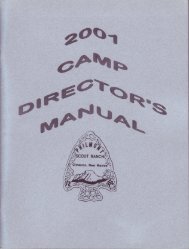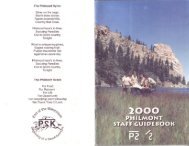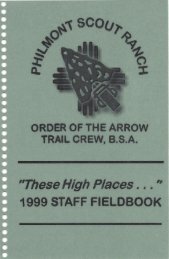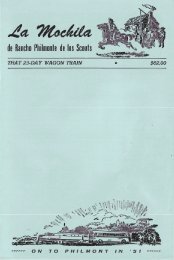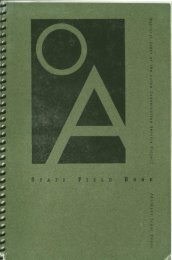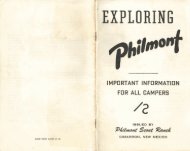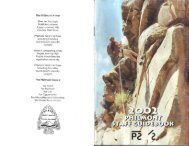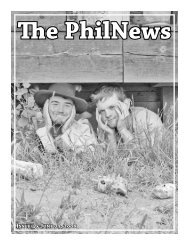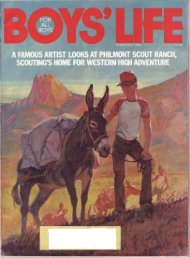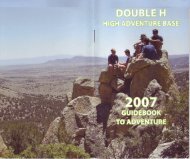Meeting Your RangerUpon arrival, your assigned Ranger will meet with you to guide your crew through the many steps necessary tocomplete your check in. Please refer to the <strong>Guide</strong>book to Adventure for an outline of Day 1 activities. Pleasecarry all of your <strong>Philmont</strong> material with you. Having your Tour Plan, Crew Roster, Talent Release form, CPR andWilderness First Aid training certification, alphabetized medical forms, and any other required paperwork willsave you time.Advisor’s Orientation, Crew Leader, Chaplain’s Aide, & Wilderness Pledge Guia MeetingsThese important meetings start at 5:45 pm of your Arrival Day. Although they are separate meetings,attendance is required. The Advisors get last minute information; the Crew Leader learns crew organizationskills; the Chaplain’s Aide becomes crew motivator, and the Wilderness Pledge Guia learns responsibilities forhelping the crew achieve wilderness ethics standards. By 6:45 pm, everyone is back together and off to ChapelServices conducted each evening at 7:00 pm in the Catholic, Jewish, Protestant, and L.D.S. traditions. The Toothof Time Traders and all Base Camp functions close so as to not interfere with religious services.<strong>Philmont</strong> Museums<strong>Philmont</strong> maintains three world famous museums that you won’t want to miss: the beautiful Villa <strong>Philmont</strong>e(Waite Phillips’ summer home), the <strong>Philmont</strong> Museum and Seton Memorial Library and Gift Shop, and thehistoric Kit Carson Museum at Rayado. Each is open every day of the summer. Tours of the Villa are scheduledat the <strong>Philmont</strong> Museum. Daily bus service, at no charge, is available to transport crews to Rayado for tours ofthe Kit Carson Museum. Schedule this at Logistics.The Scouting Way<strong>Philmont</strong> is a large community made up of several thousand excited participants and dedicated staff members.It’s a magical place where strong self-esteem is built as participants overcome the challenges of the trek. Ourcore values are expressed in the Scout Oath and Law. <strong>Philmont</strong> expects and requires everyone to do their bestto live by these principals. The Boy Scouts of America prohibit language or behavior that is obscene, belittling,offensive to persons of the opposite sex, or contain racial or religious slurs.Preserving Scouting’s Paradise for Future GenerationsFor seventy-four years <strong>Philmont</strong> has been considered the finest youth camping and backpacking area in theworld. Over 950,000 youth and adults have hiked the magnificent trails, camped in pristine campsites, andenjoyed spectacular views of the Rocky Mountains. Everyone must do his or her part to help preserve thiswonderful place by fully committing to <strong>Philmont</strong>’s Wilderness Pledge!The Wilderness Pledge areas of emphasis are:• LITTER and GRAFFITI — Each camper should make sure that all trails and campsites are left neat andclean. Camping Headquarters should be left in a like manner.• WILDLIFE — Respect <strong>Philmont</strong>'s wildlife, including livestock. Follow all guidelines regarding foodhandling and trash disposal. Never feed or harass wild animals.• WATER — You are in a land where water is scarce and very precious. Conservation and wise use ofwater has been practiced since the first man entered this land. You must continue this proper use. Youshould never bathe, do laundry, or wash dishes in or near springs or streams. Everyone needs water,and you should always leave springs and streams as clean as you found them.• TRAILS — Pledge yourself to respect all trails of <strong>Philmont</strong>. Do not cut green boughs or trees, or mark onthem. Do not cut across switchbacks and do not alter or change trail signs.• CAMPSITES — Camp only in sites designated with a numbered wood block sign. Each crew isresponsible for leaving a neat and orderly campsite, whether it is in Camping Headquarters, staffedcamps, or trail camps. Your campsite must be left litter free with its latrine and sumps clean. Carry outall trash. Fires must be left DEAD OUT and then cleaned of debris before you depart. Leave a courtesywoodpile when possible. You should respect the feelings of those crews camping near you and thosethat will come after you.<strong>2012</strong> ITINERARY GUIDE 12 PHILMONT SCOUT RANCH, BSA
Low impact camping is practiced on <strong>Philmont</strong> property. These techniques along with the Wilderness Pledge andLeave No Trace keep <strong>Philmont</strong> pristine and natural.Leave No Trace camping and hiking methods are used in the Valle Vidal lands in agreement with the CarsonNational Forest and have brought <strong>Philmont</strong> and Scouting high praise. Crews trekking into the Valle Vidal will beinstructed in Leave No Trace techniques. We also use Leave No Trace methods in our land use agreements withTed Turner’s Vermejo Park Ranch, the Barker Wildlife Area of the New Mexico Department of Game and Fish,and John Kimberlin’s Ponil Ranch. The sum of our use in these neighboring properties is about 85,000 acres.Contribute to <strong>Philmont</strong>’s Conservation PlanThree hours of conservation work is expected of each camper to earn the <strong>Philmont</strong> Arrowhead Patch. Tenhours of conservation work is required for the Fifty-Miler Award. The three hours earned at <strong>Philmont</strong> can beapplied to the Fifty-Miler Award — the other seven may be acquired back home. Some or all of the other sevenhours may also be acquired at <strong>Philmont</strong>. Several itineraries pass through more than one conservation worksite.A minimum of three hours, however, must be spent doing trail construction or other projects supervised by atrained <strong>Philmont</strong> staff member.<strong>Philmont</strong> has several conservationists located strategically throughout the backcountry. Additional informationabout locations for your crew to perform a project will be shared with the crew during Trip Planning at Logisticson Day 1. Most conservation projects at <strong>Philmont</strong> consist of trail construction or repair. This is vitally importantwhen over 23,000 people use the backcountry each year. Other projects may include watershed, timber stand,and fish habitat improvements. Long pants and hiking boots are needed for all conservation projects.For additional information, also visit the official <strong>Philmont</strong> Scout Ranch website at www.<strong>Philmont</strong>ScoutRanch.org and theTooth of Time Traders at www.ToothofTimeTraders.com.<strong>2012</strong> ITINERARY GUIDE 13 PHILMONT SCOUT RANCH, BSA





